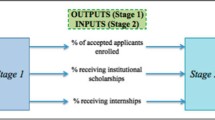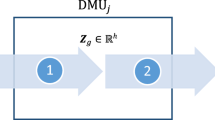Abstract
A two-stage production process assumes that the first stage transforms external inputs to a number of intermediate measures, which then are used as inputs to the second stage that produces the final outputs. The fundamental approaches to two-stage network data envelopment analysis are the multiplicative and the additive efficiency-decomposition approaches. Both they assume a series relationship between the two stages but they differ in the definition of the overall system efficiency as well as in the way they conceptualize the decomposition of the overall efficiency to the efficiencies of the individual stages. In this paper, we first show that the efficiency estimates obtained by the additive decomposition method are biased, by unduly favouring one stage against the other, while those obtained by the multiplicative method are not unique. Then, we present a novel approach to estimate unique and unbiased efficiency scores for the individual stages, which are then composed to obtain the efficiency of the overall system, by selecting the aggregation method a posteriori. Within the particularity of two-stage processes emerging from the conflicting role of the intermediate measures, we develop an envelopment model to locate the efficient frontier whose derivation from our primal multiplier efficiency assessment model is effectively justified. The results derived from our approach are compared with those obtained by the aforementioned basic methods on experimental data as well as on test data drawn from the literature. Similarities and dissimilarities in the results are rigorously justified.






Similar content being viewed by others
References
Banker RD, Charnes A, Cooper WW (1984) Some models for estimating technical and scale inefficiencies in data envelopment analysis. Manage Sci 30:1078–1092
Castelli L, Pesenti R, Ukovich W (2010) A classification of DEA models when the internal structure of the decision making units is considered. Ann Oper Res 173:207–235
Charnes A, Cooper WW (1962) Programming with linear fractional functional. Naval Res Logist 9:181–185
Charnes A, Cooper WW, Rhodes E (1978) Measuring the efficiency of decision making units. Eur J Oper Res 2:429–444
Chen Y, Zhu J (2004) Measuring information technology’s indirect impact on firm performance. Inf Technol Manage 5:9–22
Chen Y, Cook WD, Li N, Zhu J (2009) Additive efficiency decomposition in two-stage DEA. Eur J Oper Res 196:1170–1176
Chen Y, Cook WD, Zhu J (2010) Deriving the DEA frontier for two-stage DEA processes. Eur J Oper Res 202:138–142
Chen Y, Cook WD, Kao C, Zhu J (2013) Network DEA pitfalls: divisional efficiency and frontier projection under general network structures. Eur J Oper Res 226:507–515
Cook WD, Hababou M (2001) Sales performance measurement in bank branches. Omega 29:299–307
Färe R, Grosskopf S (1996) Productivity and intermediate products: a frontier approach. Econ Lett 50:65–70
Geoffrion AM (1968) Proper efficiency and theory of vector maximization. J Math Anal Appl 22:618–630
Kao C, Hwang S-N (2008) Efficiency decomposition in two-stage data envelopment analysis: an application to non-life insurance companies in Taiwan. Eur J Oper Res 185:418–429
Kao C, Hwang S-N (2011) Decomposition of technical and scale efficiencies in two-stage production systems. Eur J Oper Res 211:515–519
Liang L, Cook WD, Zhu J (2008) DEA models for two-stage processes: game approach and efficiency decomposition. Naval Res Logist 55:643–653
Seiford LM, Zhu J (1999) Profitability and marketability of the top 55 US commercial banks. Manage Sci 45(9):1270–1288
Tone K, Tsutsui M (2009) Network DEA: a slacks-based measure approach. Eur J OperRes 197:243–252
Acknowledgments
The authors wish to thank the two anonymous reviewers for their constructive comments, which helped us improve the quality of the paper. This research has been co‐financed by the European Union (European Social Fund–ESF) and Greek national funds through the Operational Program “Education and Lifelong Learning” of the National Strategic Reference Framework (NSRF)—Research Funding Program: THALES-Investing in knowledge society through the European Social Fund.
Author information
Authors and Affiliations
Corresponding author
Rights and permissions
About this article
Cite this article
Despotis, D.K., Koronakos, G. & Sotiros, D. Composition versus decomposition in two-stage network DEA: a reverse approach. J Prod Anal 45, 71–87 (2016). https://doi.org/10.1007/s11123-014-0415-x
Published:
Issue Date:
DOI: https://doi.org/10.1007/s11123-014-0415-x
Keywords
- Data envelopment analysis (DEA)
- Two-stage process
- Network DEA
- Decomposition
- Composition
- Efficient frontier




